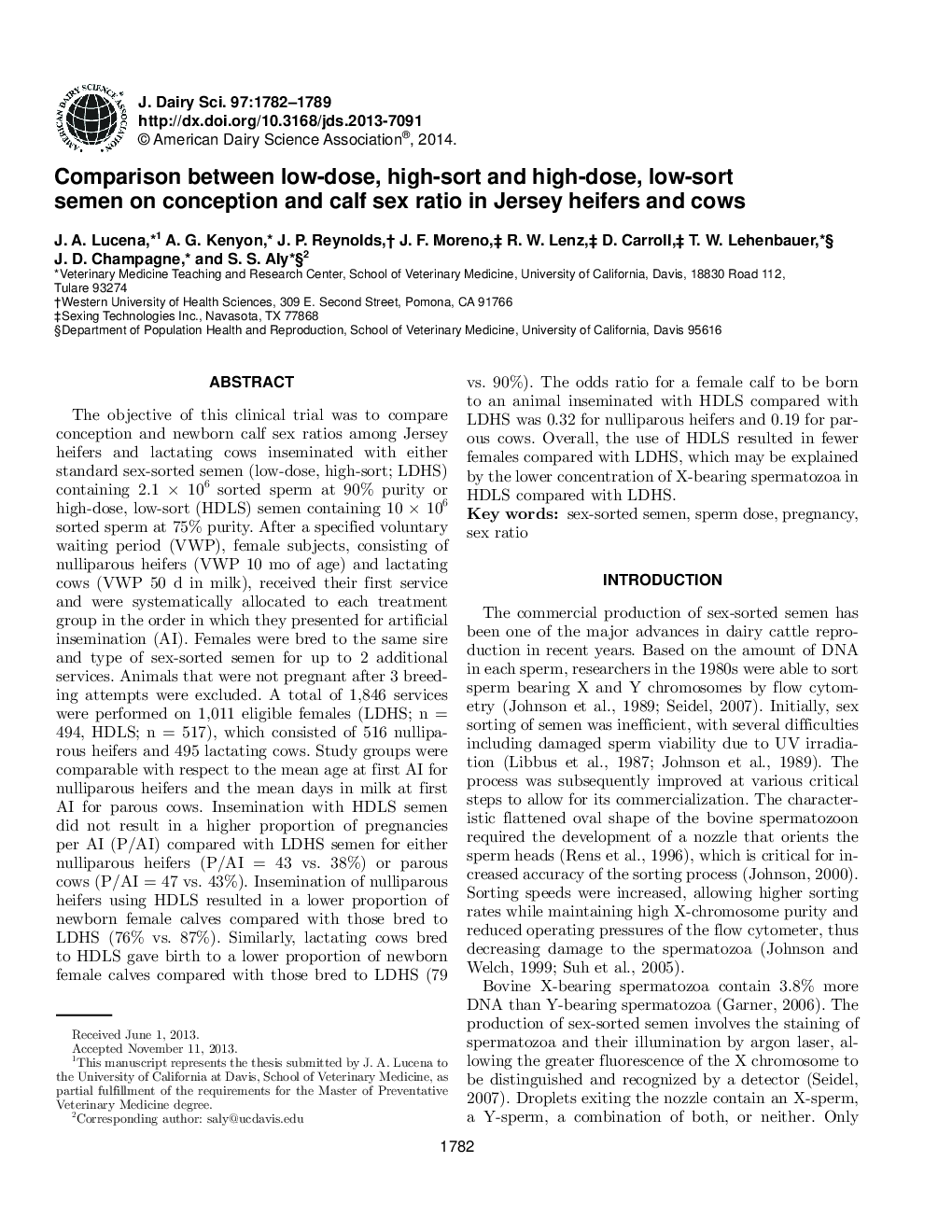| کد مقاله | کد نشریه | سال انتشار | مقاله انگلیسی | نسخه تمام متن |
|---|---|---|---|---|
| 10975199 | 1108031 | 2014 | 8 صفحه PDF | دانلود رایگان |
عنوان انگلیسی مقاله ISI
Comparison between low-dose, high-sort and high-dose, low-sort semen on conception and calf sex ratio in Jersey heifers and cows
ترجمه فارسی عنوان
مقایسه دوز پایین، دوز بالا، دوز بالا و دوز بالا، اسپرم کم مرتب بر روی میزان مورفولوژیکی و نسبت جنسی کالری در تلیسه ها و گاوهای جرسی
دانلود مقاله + سفارش ترجمه
دانلود مقاله ISI انگلیسی
رایگان برای ایرانیان
کلمات کلیدی
منی جنسی مرتب شده دوز اسپرم بارداری، نسبت جنسی،
موضوعات مرتبط
علوم زیستی و بیوفناوری
علوم کشاورزی و بیولوژیک
علوم دامی و جانورشناسی
چکیده انگلیسی
The objective of this clinical trial was to compare conception and newborn calf sex ratios among Jersey heifers and lactating cows inseminated with either standard sex-sorted semen (low-dose, high-sort; LDHS) containing 2.1 Ã 106 sorted sperm at 90% purity or high-dose, low-sort (HDLS) semen containing 10 Ã 106 sorted sperm at 75% purity. After a specified voluntary waiting period (VWP), female subjects, consisting of nulliparous heifers (VWP 10 mo of age) and lactating cows (VWP 50 d in milk), received their first service and were systematically allocated to each treatment group in the order in which they presented for artificial insemination (AI). Females were bred to the same sire and type of sex-sorted semen for up to 2 additional services. Animals that were not pregnant after 3 breeding attempts were excluded. A total of 1,846 services were performed on 1,011 eligible females (LDHS; n = 494, HDLS; n = 517), which consisted of 516 nulliparous heifers and 495 lactating cows. Study groups were comparable with respect to the mean age at first AI for nulliparous heifers and the mean days in milk at first AI for parous cows. Insemination with HDLS semen did not result in a higher proportion of pregnancies per AI (P/AI) compared with LDHS semen for either nulliparous heifers (P/AI = 43 vs. 38%) or parous cows (P/AI = 47 vs. 43%). Insemination of nulliparous heifers using HDLS resulted in a lower proportion of newborn female calves compared with those bred to LDHS (76% vs. 87%). Similarly, lactating cows bred to HDLS gave birth to a lower proportion of newborn female calves compared with those bred to LDHS (79 vs. 90%). The odds ratio for a female calf to be born to an animal inseminated with HDLS compared with LDHS was 0.32 for nulliparous heifers and 0.19 for parous cows. Overall, the use of HDLS resulted in fewer females compared with LDHS, which may be explained by the lower concentration of X-bearing spermatozoa in HDLS compared with LDHS.
ناشر
Database: Elsevier - ScienceDirect (ساینس دایرکت)
Journal: Journal of Dairy Science - Volume 97, Issue 3, March 2014, Pages 1782-1789
Journal: Journal of Dairy Science - Volume 97, Issue 3, March 2014, Pages 1782-1789
نویسندگان
J.A. Lucena, A.G. Kenyon, J.P. Reynolds, J.F. Moreno, R.W. Lenz, D. Carroll, T.W. Lehenbauer, J.D. Champagne, S.S. Aly,
